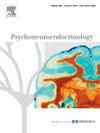Estrogen receptor alpha (ERα) partially modulates ketamine's sustained anxiolytic effects without altering its antidepressant properties in female rats
IF 3.6
2区 医学
Q2 ENDOCRINOLOGY & METABOLISM
引用次数: 0
Abstract
Ketamine is a rapid-acting antidepressant with sexually dimorphic effects. Female animals exhibit a higher sensitivity to its antidepressant properties, which has been associated with their ovarian hormone levels. One factor contributing to this sex difference is the faster rate of ketamine metabolism observed in females, potentially regulated by estrogen receptor alpha (ERα) through modulation of enzymatic activity. In this study, we explored the role of ERα in mediating the therapeutic effects of ketamine in adult female Wistar rats. To inhibit ERα, we administered its antagonist, methyl-piperidino-pyrazole (MPP; 1 mg/kg, IP), 24 h and 1 h prior to a single antidepressant dose of ketamine (10 mg/kg, IP) or saline (vehicle). We tested the animals in the forced swim test (FST), open field test (OFT), elevated plus maze (EPM), and auditory fear conditioning. Ketamine administration ameliorated behavioral despair observed in the vehicle group, and ERα antagonism did not affect this outcome. An interaction between MPP and ketamine was observed in anxiety-like behaviors assessed in the OFT and EPM; however, this effect did not reach significance in post-hoc analyses. Neither MPP nor ketamine affected fear memory, as measured in cued fear conditioning. These findings suggest that the sexually dimorphic antidepressant effects of ketamine occur independently of ERα activity, although ERα may influence neural circuits related to anxiety.
雌性大鼠雌激素受体α在不改变其抗抑郁特性的情况下部分调节氯胺酮的持续抗焦虑作用
氯胺酮是一种速效抗抑郁剂,具有性别双态效应。雌性动物对氯胺酮的抗抑郁特性更敏感,这与它们的卵巢激素水平有关。造成这种性别差异的一个因素是,雌性动物的氯胺酮代谢速度更快,这可能是受雌激素受体α(ERα)通过调节酶活性调节的。在这项研究中,我们探讨了ERα在调解氯胺酮对成年雌性Wistar大鼠的治疗效果中的作用。为了抑制ERα,我们在给大鼠注射氯胺酮(10 mg/kg, IP)或生理盐水(载体)单次抗抑郁剂量之前的24小时和1小时分别注射了ERα的拮抗剂甲基哌啶吡唑(MPP;1 mg/kg, IP)。我们对动物进行了强迫游泳试验(FST)、开阔地试验(OFT)、高架迷宫(EPM)和听觉恐惧条件反射试验。氯胺酮能改善载体组动物的行为绝望,而ERα拮抗剂对这一结果没有影响。在 OFT 和 EPM 评估的焦虑样行为中,观察到 MPP 和氯胺酮之间的交互作用;但是,这种效应在事后分析中没有达到显著性。无论是 MPP 还是氯胺酮都不会影响恐惧记忆,这是在诱导恐惧条件反射中测得的结果。这些研究结果表明,氯胺酮的性双态抗抑郁作用与ERα活性无关,尽管ERα可能会影响与焦虑有关的神经回路。
本文章由计算机程序翻译,如有差异,请以英文原文为准。
求助全文
约1分钟内获得全文
求助全文
来源期刊

Psychoneuroendocrinology
医学-精神病学
CiteScore
7.40
自引率
8.10%
发文量
268
审稿时长
66 days
期刊介绍:
Psychoneuroendocrinology publishes papers dealing with the interrelated disciplines of psychology, neurobiology, endocrinology, immunology, neurology, and psychiatry, with an emphasis on multidisciplinary studies aiming at integrating these disciplines in terms of either basic research or clinical implications. One of the main goals is to understand how a variety of psychobiological factors interact in the expression of the stress response as it relates to the development and/or maintenance of neuropsychiatric illnesses.
 求助内容:
求助内容: 应助结果提醒方式:
应助结果提醒方式:


